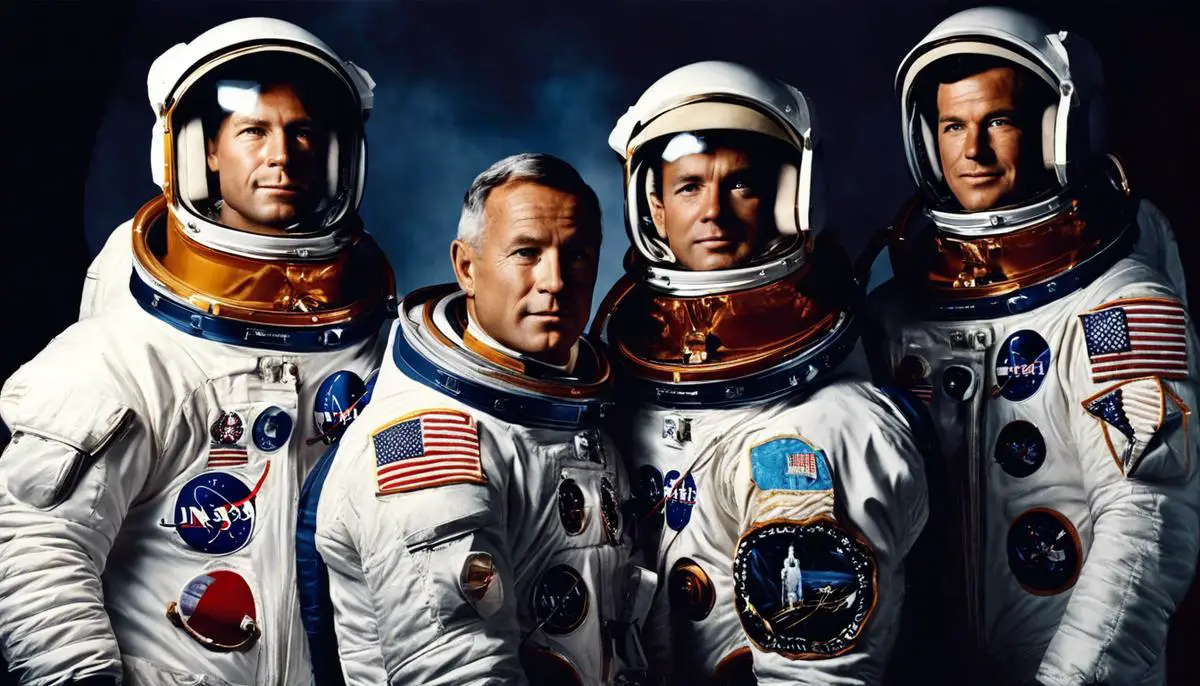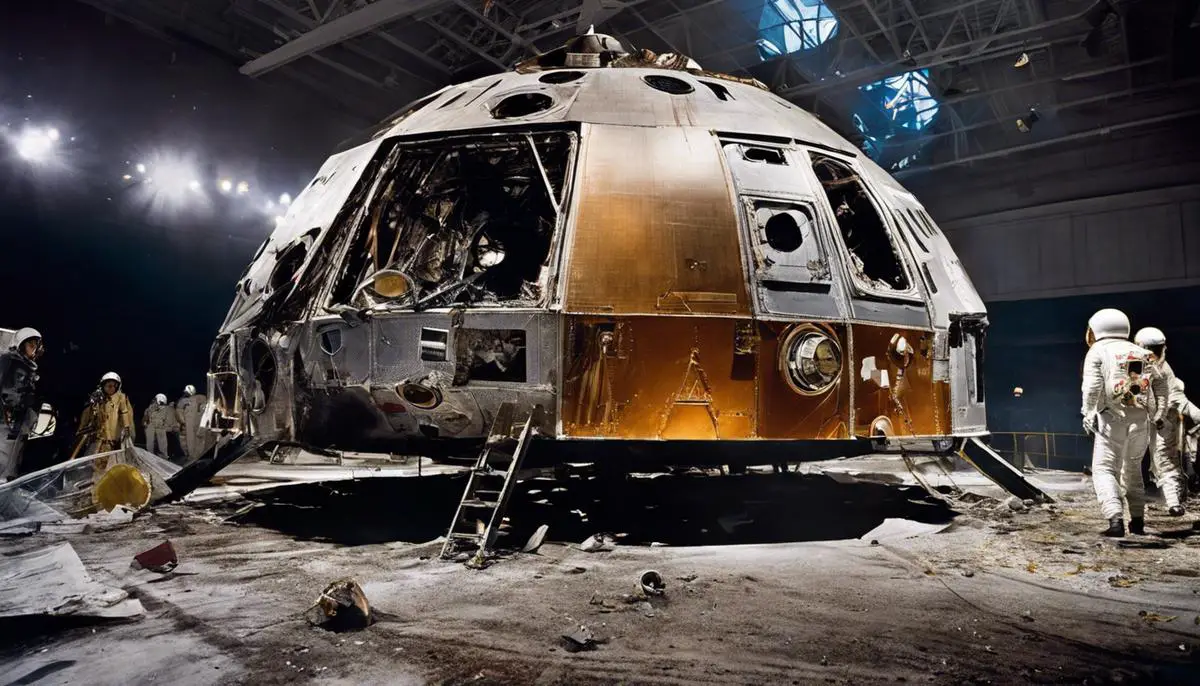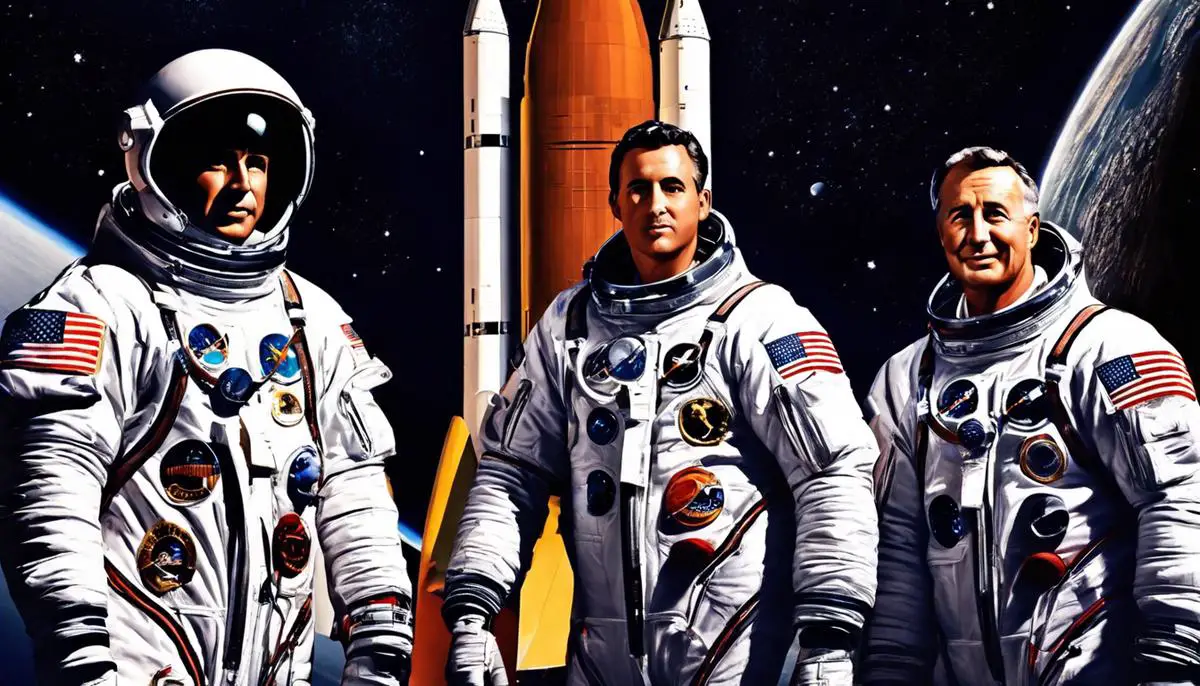In the annals of American space exploration, certain missions stand tall with their significant contributions, and few come with a tale as poignant as that of Apollo 1. This essay embarks on a journey into the lives of the valiant astronauts Gus Grissom, Ed White, and Roger Chaffee, illuminating their career trajectories, their grueling training and preparation, and the tragic conclusion that sealed their fate. Each of these courageous men carried a unique background and path that led them to the same destination – Apollo 1. Their resilience and dedication contributed immensely to the field of space exploration and their story casts light on the human aspects of the indomitable spirit of exploration.
Contents
Career trajectories of Apollo 1 Astronauts
In unraveling the vibrant tapestry of human achievement in space exploration, it is imperative that we delve into the individual threads of the remarkable astronauts who paved the path. The Apollo 1 mission, emblematic of raw courage and unbridled ambition, brought together three exceptionally talented astronauts: Virgil I. “Gus” Grissom, Edward H. White II, and Roger B. Chaffee.
Virgil I. “Gus” Grissom, oft-cited for his dogged determination and strategic mind, was born in 1926 in Indiana. Demonstrating an early prowess in mechanical skills, Grissom enlisted for aviation cadet training during World War II where he honed his skills as a pilot. Post-war found Grissom embracing academia and pursuing a degree in Mechanical Engineering from Purdue University. After graduating with honors, he entered the U.S. Air Force where he served as a jet pilot in the Korean War. Later, he completed a bachelor’s degree in Aeromechanics from the Air Force Institute of Technology, following it with rigorous training at the USAF Test Pilot School, where his acumen for complex problem solving was further refined.
Edward H. White II, celebrated for his immense love for space and relentless pursuit of technical mastery, was born in 1930 in San Antonio, Texas. Tracing his passion for aviation back to his early years, courtesy of his father who was a Major General in the U.S. Air Force. Edward followed suit and attended the U.S. Military Academy at West Point, graduating in 1952. His subsequent assignment as a pilot in the Fighter Squadron in Germany was instrumental in bolstering his combat skills. From there, he pursued further education at the University of Michigan where he obtained a Master’s degree in Aeronautical Engineering. His commendable performance at the USAF Experimental Flight Test Pilot School played a critical role in carving his path towards NASA.
Roger B. Chaffee, renowned for his quick-thinking abilities and his unassuming demeanor, took a slightly different path. Born in Grand Rapids, Michigan in 1935, he manifested an interest in aviation very early on. His passion drove him to join the Naval Reserve Officers Training Corps while studying Aeronautical Engineering at Purdue University. He graduated in 1957 and soon after, joined the Navy where he served as a pilot, completing over 2,100 hours of flying. His distinctive strategic thinking skills were subsequently shaped during his tenure at the Naval Air Station, where he was responsible for the fitness of reconnaissance aircraft.
The roads leading these remarkable individuals to Apollo 1 were unique but intertwined, crafted through a combination of higher education, technical training, military service, and passion; all bolstered by a relentless pursuit of excellence. Each astronaut, with their exceptional skills and boundless courage, contributed significantly to the robust foundation upon which the edifice of U.S. space exploration stands today. The legacy of their stellar achievements, imprinted on the canvas of space, continues to inspire generations navigating the labyrinth of astronaut training and unending discovery. In understanding their earnest beginnings, we uncover precious insights into the invaluable qualities necessary to negotiate the unforgiving expanse of space.

Training and Preparation
Unveiling Apollo 1: Rigorous Training and Preparation Framework of the Chosen Three
Apollo 1, the initial crewed spacecraft of the illustrious Apollo program, projected to be the first voyage to land humans on the moon, enlisted three exceptional American astronauts: Virgil I. “Gus” Grissom, Edward H. White II, and Roger B. Chaffee. Their journey to space was not spontaneous; it was meticulously planned and necessitated extensive and rigorous training.
The three astronauts underwent unprecedented astronautical training within the framework of the NASA Astronaut Group 2 and Group 3 respectively. This multi-faceted training fortified their adeptness in executing their mission objectives, withstanding the physical extremes of space, and managing emergency contingencies.
Understanding the spacecraft’s functionality was pivotal to their training regimen. They acquired a sound comprehension of Command Module (CM) operations, getting extensively familiarized with the spacecraft’s operations manuals and schematics, participating in numerous spacecraft systems and equipment briefings, and, importantly, many hours undertaking CM simulator training. This hands-on experience allowed them to virtually experience the mission, with simulation trials ranging from normal mission sequences to equipment failures, software bugs, and emergency scenarios.
Aside from the technical training, physical fitness was central to the astronauts’ preparation. Rigorous cardiovascular conditioning, strength training, altitude training, and underwater survival techniques were all integrated into their fitness regimen. The astronauts’ physical preparedness was tested to the core with the rigors of zero-gravity and the harsh environment of space in mind.
A poignant component of their training framework involved survival training. This was beholden to the possibility of their re-entry into Earth landing them in remote regions. This comprehensive survival training was assimilated across different terrains, from desert survival training at Reno, Nevada and the Panama Canal Zone to jungle and water survival training. Critical skills including navigation, shelter construction, and special signaling were enriched during this regimen.
Training in zero-g conditions was another indispensable aspect of their preparation. This was achieved through parabolic flight in a NASA-modified aircraft, popularly known as the “Vomit Comet”. These sessions not only tested their physical resilience, but also mental toughness, enabling them to adapt to the disorienting environment of microgravity.
Exposure to high-stress conditions was an equally important part of their training. This included egress training, firefighting drills, pressure suit training, and the demanding launchpad egress training, which simulated emergency escapes utilizing zip-lines at heights comparable to the Saturn launch vehicles.
The training of Grissom, White, and Chaffee aptly manifests the enormity of effort behind the Apollo missions and evokes deep respect for the astronauts’ unyielding determination, stamina, and commitment to advancing human endeavors in space. This narrative of their training illuminates the rigor and determination necessary for such a storied adventure, ensuring that the legacy of the Apollo 1 crew continues to inspire.

Tragic Conclusion: Apollo 1 Fire
The combustion within a confined spacecraft is of considerable scientific interest, a grim scenario that the Apollo 1 mission tragically brought into focus on January 27th, 1967. On this tragic day, a fire that originated in the Apollo Command Module (CM) took the lives of three space pioneers – Virgil I. “Gus” Grissom, Edward H. White II, and Roger B. Chaffee.
It’s crucial to comprehend the contributing factors to this calamitous event. During a simulation, known as a ‘plugs-out’ test, the Apollo 1 crew were in the CM, made of high-strength aluminum alloy, which was pressurized and filled with pure oxygen. Fire safety is of utmost importance during such tests, for even a tiny spark may cause a violent combustion in a pure oxygen environment. That was precisely what happened: a spark, from an undetermined source, instigated a fire that rapidly escalated within the pressurized, oxygen-filled cabin.
The spacecraft design also exacerbated the situation. Its hatch, designed to keep a pressure seal and protect astronauts during the mishap of unintentional re-entry, had a complex and time-consuming mechanism. The inward-opening design of the hatch made it impossible to open under high-pressure situations, sealing the crew members’ fate.
The aftermath of the Apollo 1 fire was a somber introspection for the NASA community. A stark realization dawned that space exploration was a challenging terrain where errors came with a high price. The investigations prompted an array of substantial modifications to spacecraft design, operational techniques, and quality control procedures for crewed space flights.
The Apollo Command Module saw significant changes. The hatch was redesigned for rapid outward opening in less than five seconds. The cabin atmosphere for ground tests and the beginning periods of flights were altered to a less flammable mixture of 60% oxygen and 40% nitrogen. Materials used within the cabin were rigorously tested and selected based on their resistance to ignition and fumes.
Quality control procedures became more stringent, emphasizing rigorous pre-flight preparation and cover safety. Similarly, multiple technical and organizational recommendations were also implemented to prevent any such future mishaps.
The Apollo 1 fire indeed marked a dark day in the annals of space history. However, it also provoked a paradigm shift within NASA towards ensuring a higher level of safety for astronauts. Every subsequent mission carries the legacy of Apollo 1, reminders of the dangers at every juncture, and the unyielding necessity for caution, meticulous preparation, and diligent respect for the unknown that makes up much of space exploration.

While the Apollo 1 incident was a calamitous chapter in the history of NASA, it sparked crucial enhancements in spaceflight safety and risk management. The lives and contributions of Grissom, White, and Chaffee have ceaselessly resonated in the annals of space exploration. Their lives, their training, their courage, and their ultimate sacrifice paint a vivid portrait of human endeavor at its bravest and most committed. The legacy they left behind echoes in the heart of every manned space mission, a relentless reminder that space exploration, while delimited with risks, is a journey of resilience and relentless pursuit of the unknown.
